CROATIA
Zadar

Zadar
Zadar
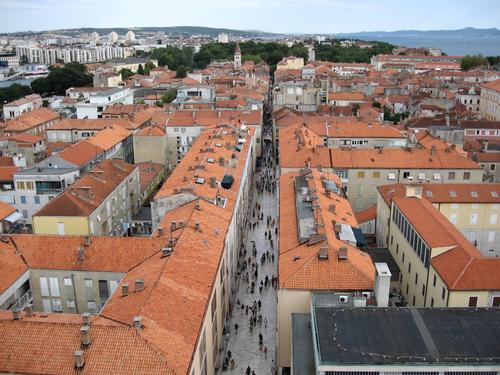 ZadarPhoto: Joadl CC 3.0 Unported no changes made
ZadarPhoto: Joadl CC 3.0 Unported no changes made
Zadar is one of Croatia's favorite Dalmatian destinations and is a steadily gaining popularity. It is an old city with a number of beautiful beaches in the area, Zadar has impressive Roman ruins in the old core and dozens of beautiful churches. In addition, there are beautiful islands and national parks within easy reach and the shops, cafes and nightlife are also very good. The daily market in Zadar is not to be missed and is one of the best in Croatia, with tons of fresh produce and seasonal delicacies.
| advertisement |
| Hotels Zadar |
Location
The city is located above Split and Dubrovnik on the Dalmatian coast, about a three-hour drive (285 kilometers) southwest of the capital, Zagreb. The harbor is located to the northeast of the old core, the Kolovare residential area is to the east and the bustling suburb of Borik to the north.
Weather
Zadar has a Mediterranean climate, with warm, dry summers and cool, wet winters. Summer runs from June to September, when it is hot and the nights are warm. In May and October the weather is usually still very decent. Spring is more beautiful than autumn, because it is much drier then. Winter is not the best time to visit Zadar as it is wet and cold most days. A nasty wind is blowing from the north. The only good points of a visit in winter are less crowds and lower prices.
History
Zadar is widely regarded as the historic center of Dalmatia. Like most towns on the Adriatic coast, Zadar's history began centuries ago as a settlement for Mediterranean maritime trade.
The Liburnians established a port city on a narrow rocky island in the 7th century BC. Where the old town of Zadar can be found today. The Liburnians were one of the great maritime and trading societies of the ancient world. Zadar was an important hub for maritime trade in the Mediterranean between the Etruscans, Greeks and Phoenicians.
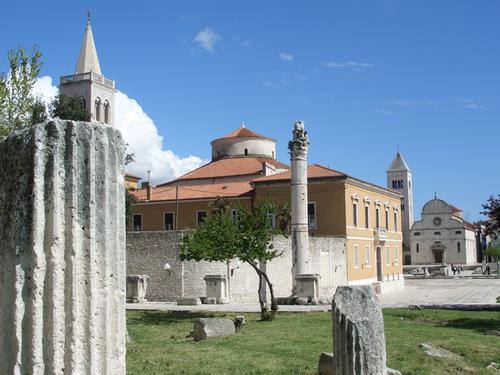 Zadar remains of Forum RomanumPhoto: Maestralno in the public domain
Zadar remains of Forum RomanumPhoto: Maestralno in the public domain
The Romans started their invasion of the Dalmatian region in the 2nd century BC. Zadar was incorporated into the Roman Empire under Julius Caesar in the year 59 BC and from then on it became a forced ally for Roman naval adventures in the area. The city developed and acquired a Roman character and became one of the most popular ports on the eastern Adriatic coast. It remained an important Roman outpost for centuries and the Forum and the 40-kilometer aqueduct can still be admired.
After the fall of the Roman Empire, Zadar was devastated by the Huns and the Goths, before the Byzantine Emperor Justinian the Great recaptured the Western Empire with his crusade. This era spawned a number of important buildings in Zadar's history, such as the 9th century Church of St. Donatus and the city became the capital of Byzantine Dalmatia. Eventually the city became part of the Croatian-Hungarian state.
By the 12th century, Venice had become a huge power and it regularly attacked and looted Zadar in the early 13th century. The citizens tried to rebel against the Venetians, often with the help of the Croatian-Hungarian kings of the 13th and 14th centuries. Finally, in 1409 the city was sold to Venice, along with the rest of Dalmatia. In response to the Turkish threat, the Venetians built defensive city walls in the 16th century.
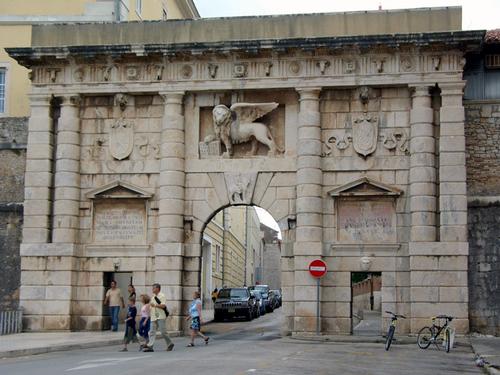 Venetian gateway ZadarPhoto: Maestralno in the public domain
Venetian gateway ZadarPhoto: Maestralno in the public domain
When Venice itself eventually fell at the end of the 18th century, the city was alternately owned by the Austrians and the French for several decades. The Austrians employed Italians to run the city and so Italian culture had a lasting influence on Zadar's history well into the 20th century.
Zadar was excluded from the newly formed Kingdom of Yugoslavia and remained an Italian province during the World Wars. When the Allies expelled Italy from Dalmatia in 1943, they bombed the Old Town. The city was rebuilt to the original street pattern, which means that visitors can still enjoy the narrow pedestrian streets of the historic core. Zadar suffered greatly from the war in the former Yugoslavia. The city was shelled from 1991 to 1993 and cut off from the surrounding region.
Sights
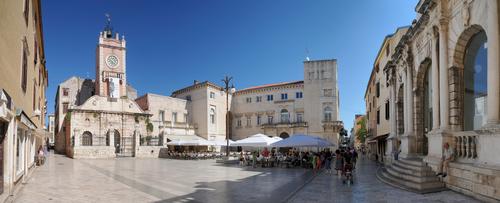 Zadar Central SquarePhoto: Böhringer Friedrich CC 2.5 Generic no changes made
Zadar Central SquarePhoto: Böhringer Friedrich CC 2.5 Generic no changes made
Zadar is full of tourist attractions, from beaches, squares and promenades to old churches and Roman ruins. The peninsula of the old town is bordered by water and this is the part of Zagreb where many of the oldest churches are situated, along with the remains of the Forum Romanum. A special attraction in the old town of Zadar is the promenade Riva. Although only parts of the medieval city walls and gates remain, tourists can still see the former grandeur with a little imagination. Below are some of the sights of Zadar.
Zadar's Roman Forum was built between the 1st century BC and the 3rd century AD. The Forum was completed under Emperor Augustus and included a temple to Jupiter, Juno and Minerva, places of sacrifice, meeting rooms and shops. Only the pavers, some walls and sections of the staircase can be seen today, along with a huge column called the Pillar of Shame. When one of the residents misbehaved he or she was chained as a form of public humiliation.
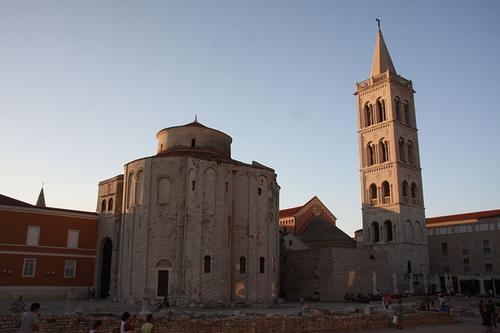 Zadar St DonatPhoto: Mark Heard CC 2.0 Generic no changes made
Zadar St DonatPhoto: Mark Heard CC 2.0 Generic no changes made
The Church of St. Donat is built on part of the Forum, with two of the original pillars in it. The church provides a striking contrast to the old ruins and is one of the most important monuments in Dalmatia. The church is named after its founder, Bishop Donat. This austere Byzantine structure dates back to the early 9th century and is quite beautiful, with its clean lines, rounded plan and fortress-like style.
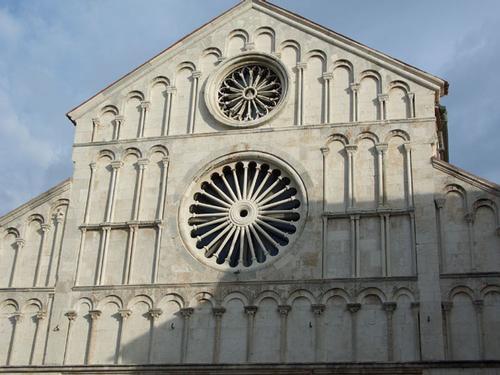 St Anastasia Cathedral ZadarPhoto: Maestralno in the public domain
St Anastasia Cathedral ZadarPhoto: Maestralno in the public domain
The St. Anastasia Cathedral is perhaps the most impressive in Zadar and is located about ten minutes walk from the old town and is best known for its beautiful Romanesque facade. Construction of the cathedral began in the 12th century and is touted as being the largest in all of Dalmatia. Highlights include the three doors and arches, as well as the marble sarcophagus, the colorful frescoes, the main altar, and the tall bell tower.
Tips
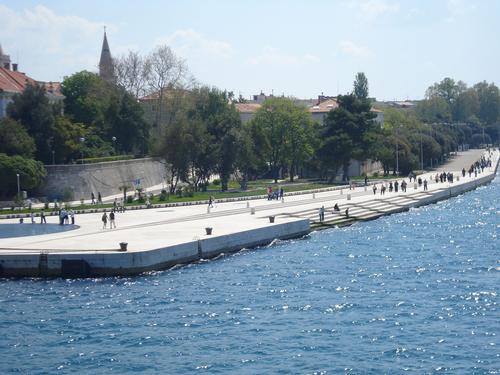 Zadar RivaPhoto: Andrej Šalov CC 3.0 Unported no changes made
Zadar RivaPhoto: Andrej Šalov CC 3.0 Unported no changes made
As with any Croatian coastal town, Zadar has its own Riva, which is a quay overlooking the sea. The Riva of Zadar is located on the southern side of the old town, overlooking the Adriatic Sea and the islands. It is a beautiful, wide boulevard lined by a series of parks and gardens, with steps leading down to the sea. In the evening, the Riva comes alive with food stalls and cafes. As you walk along the promenade, check out the somewhat crazy and rather fascinating Sea Organ.
Useful links Zadar
BBC Country ProfilesWorld Fact Book Explore all Countries
How to call
Last updated June 2025
Copyright: Team - The World of Info